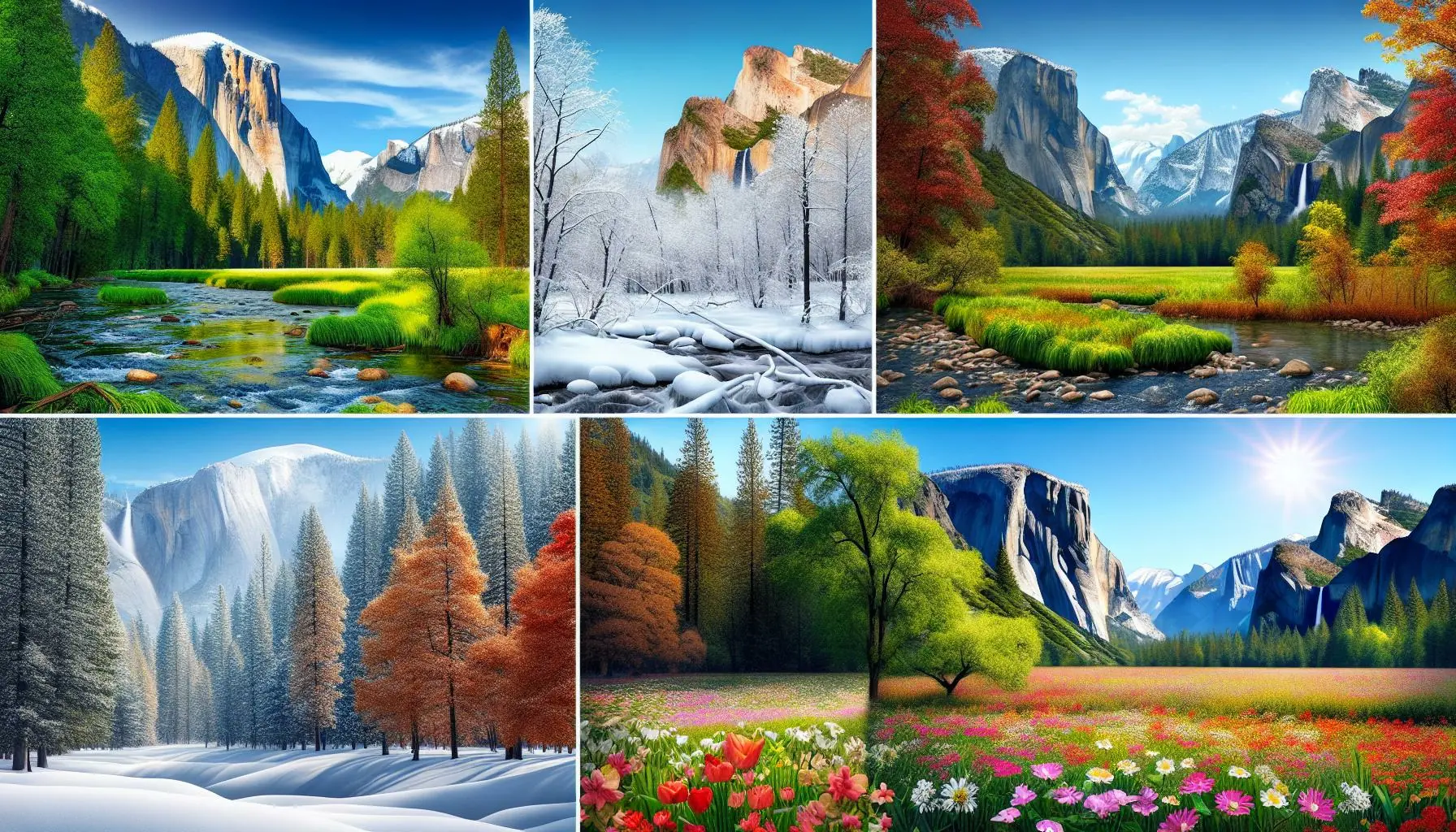Table of Contents
ToggleNestled in California’s Sierra Nevada mountains, Yosemite National Park’s weather is as dramatic as its towering granite cliffs and thundering waterfalls. From sun-soaked summer days to snow-dusted winter wonderlands, Mother Nature puts on quite a show in this natural playground.
Understanding Yosemite’s Climate Zones
Yosemite National Park spans five distinct climate zones across its 759,620 acres. The park’s elevation ranges from 2,000 feet to 13,000 feet, creating unique microclimates that shape the weather patterns throughout the region.
Valley Floor Weather Patterns
Yosemite Valley, situated at 4,000 feet elevation, experiences Mediterranean climate conditions year-round. Summer temperatures reach 90°F during July and August, while winter temperatures average 40°F from December through February. Spring brings temperatures between 50-70°F, perfect for witnessing the park’s waterfalls at peak flow. Fall temperatures range from 50-80°F, creating ideal conditions for rock climbing and hiking. The valley floor receives 37 inches of annual precipitation, with most rainfall occurring between November and March.
High Country Climate Conditions
The alpine regions above 8,000 feet maintain significantly cooler temperatures than the valley floor. Summer daytime temperatures average 65°F at Tuolumne Meadows, dropping to 30°F at night. Winter temperatures often fall below 0°F, with snowpack reaching 10 feet in areas like Tioga Pass. The high country receives 70% of its precipitation as snow between November and March. Alpine zones experience frequent afternoon thunderstorms during summer months, particularly in July and August. These areas remain snow-covered and inaccessible by car from approximately November through May.
Seasonal Weather in Yosemite

Yosemite National Park experiences distinct seasonal changes that create unique outdoor experiences throughout the year. The park’s diverse elevation ranges produce varying weather conditions across different regions.
Summer Weather and Temperatures
Summer transforms Yosemite into a sun-drenched paradise from June through September. Daytime temperatures in Yosemite Valley range from 85°F to 95°F, while evening temperatures cool to 50-60°F. The high country maintains cooler conditions with daytime highs of 65-70°F at elevations above 8,000 feet. Afternoon thunderstorms occur frequently in alpine areas, particularly between 2 PM and 6 PM. Humidity levels remain low at 30-40%, creating comfortable conditions for hiking trails like Half Dome or exploring Tuolumne Meadows.
Winter Snow and Conditions
Winter blankets Yosemite in snow from November through March. The Valley floor receives an average of 29 inches of snow annually, while higher elevations accumulate 300-400 inches. Daytime temperatures in Yosemite Valley hover between 35-45°F, dropping to 20-30°F at night. Tioga Road closes due to heavy snowfall, restricting access to the high country. Winter storms bring challenging driving conditions to park roads, requiring tire chains on vehicles. Badger Pass Ski Area opens for downhill skiing with an average base depth of 150 inches.
Spring and Fall Transitions
Spring arrives in Yosemite Valley by April, bringing temperatures between 60-70°F during the day. Waterfalls reach peak flow in May from snowmelt. Fall colors emerge in October with average temperatures of 55-75°F. Both seasons experience occasional rain showers, with spring receiving 3-4 inches monthly. Morning frost occurs in both transition seasons when temperatures drop below 32°F. These periods offer ideal conditions for rock climbing at El Capitan or photographing the changing landscape.
Weather Hazards and Safety
Yosemite’s diverse climate zones present distinct weather-related challenges throughout the year. Visitors face specific seasonal hazards that require proper preparation and awareness for safe exploration of the park.
Thunderstorms and Lightning
Summer thunderstorms strike Yosemite’s high country with intense frequency between noon and 6 PM. Lightning poses serious risks to hikers above tree line, particularly on exposed peaks like Half Dome. Visitors caught in storms experience rapid temperature drops of 20°F within minutes. The National Park Service records an average of 40 lightning-related incidents annually in Yosemite’s high-elevation areas. Safe practices include descending from peaks before storms arrive, avoiding isolated tall objects, and seeking shelter in lower-elevation forested areas.
- Emergency shelter materials rated for subfreezing temperatures
- Navigation tools that function without cellular service
- Three days of extra food supplies
- Battery-powered emergency communications device
- Tire chains certified for mountain driving
- Winter-rated sleeping bag rated to 0°F
Best Times to Visit Based on Weather
Optimal visiting periods for Yosemite depend on specific activity preferences and weather tolerance. The park offers distinct experiences across its diverse climate zones throughout the year.
Peak Season Weather Windows
Yosemite’s prime visiting window spans from late May through September when temperatures range from 70-90°F in Yosemite Valley. June delivers ideal conditions for waterfall viewing with temperatures around 75°F and minimal precipitation. July and August maintain stable weather patterns with consistent sunshine and average daytime temperatures of 87°F. Morning hours between 7-11 AM present the most comfortable conditions for hiking and rock climbing. September offers pleasant 75-80°F days with reduced crowds and crystal-clear skies perfect for photography.
| Peak Season Month | Average High (°F) | Average Low (°F) | Precipitation (inches) |
|---|---|---|---|
| June | 75 | 50 | 0.7 |
| July | 87 | 57 | 0.4 |
| August | 85 | 55 | 0.3 |
| September | 78 | 48 | 0.6 |
Off-Season Weather Considerations
October through April presents unique opportunities for experiencing Yosemite’s dramatic weather patterns. Winter months from December through February transform the landscape with snow, averaging 29 inches in the Valley and 400 inches at higher elevations. March and April bring variable conditions with temperatures ranging from 35-60°F and occasional rain showers. October and November temperatures average 45-65°F with increased precipitation chances. Early morning frost occurs regularly during these months, creating photographic opportunities of crystalline landscapes.
| Off-Season Month | Average High (°F) | Average Low (°F) | Snow Accumulation (inches) |
|---|---|---|---|
| December | 48 | 29 | 15.0 |
| January | 49 | 26 | 16.5 |
| February | 55 | 28 | 14.0 |
| March | 58 | 33 | 10.5 |
What to Pack for Yosemite’s Weather
Packing for Yosemite requires careful consideration of the season and elevation changes. The right gear ensures comfort and safety across the park’s diverse climate zones.
Summer Essentials
Lightweight moisture-wicking shirts protect against intense sun exposure at high elevations. A daypack contains essential hiking supplies including 3 liters of water per person, trail snacks, sunscreen (SPF 30+) and a first-aid kit. Sturdy hiking boots with ankle support navigate rocky terrain while moisture-wicking socks prevent blisters. Additional items include:
- UV-protective sunglasses
- Wide-brimmed hat for sun protection
- Light rain jacket for afternoon thunderstorms
- Convertible hiking pants with zip-off legs
- Insulating layer for elevation changes
- Headlamp with extra batteries
- Trail map and compass
- Insulated waterproof boots rated to -20°F
- Thermal base layers (top and bottom)
- Wool or synthetic mid-layers
- Warm hat covering ears
- Waterproof gloves with liner
- Traction devices for boots
- Snow goggles
- Emergency shelter
- Hand warmers
- Avalanche beacon in backcountry areas
- Ice axe for steep terrain
Impact of Weather on Park Activities
Yosemite’s weather patterns directly affect accessibility and safety throughout the park. These conditions influence trail availability, road status and visitor policies across different elevations and seasons.
Trail and Road Closures
Tioga Road closes annually from November through late May due to heavy snowfall. The Glacier Point Road remains inaccessible from November to April or May depending on snow conditions. Half Dome cables come down each October and return in late May when ice clears from the granite slopes. Several high-country trails above 8,000 feet become impassable from snow coverage between November and June.
| Road/Trail | Typical Closure Period | Reason |
|---|---|---|
| Tioga Road | Nov – Late May | Snow |
| Glacier Point Road | Nov – April/May | Snow |
| Half Dome Cables | Oct – Late May | Ice |
| High Country Trails | Nov – June | Snow |
Weather-Related Park Policies
The National Park Service enforces specific regulations during severe weather events. Vehicle chain requirements take effect when snow accumulates on park roads. Backcountry permits require winter camping certification from November through April. Rangers close certain climbing routes during thunderstorms or when wet conditions make granite surfaces hazardous. Fire restrictions increase during dry summer periods with high temperatures. Camping above 9,500 feet requires bear-resistant food storage due to extended snow season wildlife patterns.
Yosemite’s dynamic weather patterns shape an ever-changing landscape that offers unique experiences throughout the year. Whether visitors seek the warm sunny days of summer or the serene snowy winters they’ll find incredible natural beauty across the park’s diverse climate zones.
Planning a trip to Yosemite means understanding these weather patterns and being prepared for the conditions. With proper preparation and attention to safety guidelines visitors can safely explore this magnificent wilderness in any season. The park’s weather isn’t just a backdrop – it’s an integral part of what makes Yosemite one of America’s most spectacular natural wonders.




